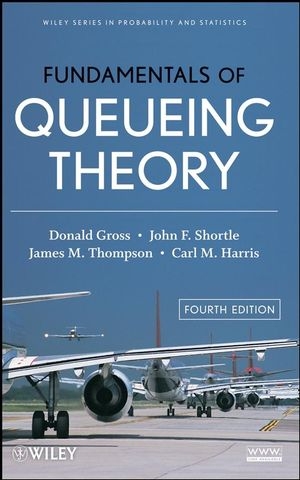
Fundamentals of Queueing Theory
Wiley-Blackwell (an imprint of John Wiley & Sons Ltd) (Verlag)
978-0-471-79127-0 (ISBN)
- Titel ist leider vergriffen;
keine Neuauflage - Artikel merken
It contains additional material (call centers and simulation), discussions (Transform Approximation Method and Level Crossing Analysis), and exercises.
Praise for the Third Edition
"This is one of the best books available. Its excellent organizational structure allows quick reference to specific models and its clear presentation . . . solidifies the understanding of the concepts being presented."
IIE Transactions on Operations Engineering
Thoroughly revised and expanded to reflect the latest developments in the field, Fundamentals of Queueing Theory, Fourth Edition continues to present the basic statistical principles that are necessary to analyze the probabilistic nature of queues. Rather than presenting a narrow focus on the subject, this update illustrates the wide–reaching, fundamental concepts in queueing theory and its applications to diverse areas such as computer science, engineering, business, and operations research.
This update takes a numerical approach to understanding and making probable estimations relating to queues, with a comprehensive outline of simple and more advanced queueing models. Newly featured topics of the Fourth Edition include:
Retrial queues
Approximations for queueing networks
Numerical inversion of transforms
Determining the appropriate number of servers to balance quality and cost of service
Each chapter provides a self–contained presentation of key concepts and formulae, allowing readers to work with each section independently, while a summary table at the end of the book outlines the types of queues that have been discussed and their results. In addition, two new appendices have been added, discussing transforms and generating functions as well as the fundamentals of differential and difference equations. New examples are now included along with problems that incorporate QtsPlus software, which is freely available via the book′s related Web site.
With its accessible style and wealth of real–world examples, Fundamentals of Queueing Theory, Fourth Edition is an ideal book for courses on queueing theory at the upper–undergraduate and graduate levels. It is also a valuable resource for researchers and practitioners who analyze congestion in the fields of telecommunications, transportation, aviation, and management science.
DONALD GROSS, PhD, is Distinguished Research Professor of Operations Research and Engineering at George Mason University and Professor Emeritus of Operations Research at The George WashingtonUniversity. With over forty years of experience in academia and consulting, Dr. Gross has published extensively in the area of queueing applications to repairable item inventory control, air traffic control, and Internet congestion. JOHN F. SHORTLE, PhD, is Associate Professor in the Department of Systems Engineering and Operations Research at George Mason University. He has authored or coauthored over thirty published articles on the application of simulation and queueing theory in telecommunications and aviation. JAMES M. THOMPSON is an Enterprise Architect at the Federal Home Loan Mortgage Corporation. His current areas of research interest include computer system performance modeling, system capacity studies and benchmarking, information architecture, and computational finance. The Late CARL M. HARRIS, PhD, was BDM International Professor and the founding chair of the Systems Engineering and Operations Research Department at George Mason University. For his research contributions to the areas of applied probability and statistics, queueing theory, simulation, and public systems analysis, Dr. Harris was awarded the George E. Kimball Medal by the Institute for Operations Research and the Management Sciences (INFORMS) in 1999.
Dedication.
Preface.
1. Introduction.
1.1 Description of the Queueing Problem.
1.2 Characteristics of Queueing Processes.
1.3 Notation.
1.4 Measuring System Performance.
1.5 Some General Results.
1.6 Simple Data Bookkeeping for Queues.
1.7 Poisson Process and the Exponential Distribution.
1.8 Markovian Property of the Exponential Distribution.
1.9 Stochastic Processes and Markov Chains.
Problems.
2. Simple Markovian Queueing Models.
2.1 Birth Death Processes.
2.2 Single–Server Queues (M/M/1).
2.3 Multi–Server Queues (M/M/c).
2.4 Choosing the Number of Servers.
2.5 Queues with Truncation (M/M/c/K).
2.6 Erlang?s Loss Formula (M/M/c/c).
2.7 Queues with Unlimited Service (M/M/1).
2.8 Finite Source Queues.
2.9 State–Dependent Service.
2.10 Queues with Impatience.
2.11 Transient Behavior.
2.12 Busy–Period Analysis.
Problems.
3. Advanced Markovian Queueing Models.
3.1 Bulk Input (M[X]/M/1).
3.2 Bulk Service (M/M[Y ]/1).
3.3 Erlangian Models.
3.4 Priority Queue Disciplines.
3.5 Retrial Queues.
4. Networks, Series, and Cyclic Queues.
4.1 Series Queues.
4.2 Open Jackson Networks.
4.3 Closed Jackson Networks.
4.4 Cyclic Queues.
4.5 Extensions of Jackson Networks.
4.6 Non–Jackson Networks.
5. General Arrival or Service Patterns.
5.1 General Service, Single Server (M/G/1).
5.2 General Service, Multi–Server (M/G/c/ú, M/G/1).
5.3 General Input (G/M/1, G/M/c).
6. More General Models and Theoretical Topics.
6.1 G/Ek/1, G[k]/M/1, and G/PHk/1.
6.2 General Input, General Service (G/G/1) .
6.3 Multichannel Queues with Poisson Input and Constant Service (M/D/c).
6.4 Semi–Markov and Markov Renewal Processes in Queueing.
6.5 Other Queue Disciplines.
6.6 Design and Control of Queues.
6.7 Statistical Inference in Queueing.
7. Bounds and Approximations.
7.1 Bounds.
7.2 Approximations.
7.3 Network Approximations.
Problems.
8. Numerical Techniques and Simulation.
8.1 Numerical Techniques.
8.2 Numerical Inversion of Transforms.
8.3 Discrete–Event Stochastic Simulation.
Problems.
Bibliography.
Appendix 1. Symbols and Abbreviations.
Appendix 2. Tables.
Appendix 3. Transforms and Generating Functions.
A3.1 Laplace Transforms.
A3.2 Generating Functions.
Appendix 4. Differential and Difference Equations.
A4.1 Ordinary Differential Equations.
A4.2 Difference Equations.
Appendix 5. QTSPlus Software.
A5.1 Instructions for Downloading.
| Erscheint lt. Verlag | 22.8.2008 |
|---|---|
| Reihe/Serie | Wiley Series in Probability and Statistics |
| Verlagsort | Chicester |
| Sprache | englisch |
| Maße | 159 x 242 mm |
| Gewicht | 870 g |
| Themenwelt | Mathematik / Informatik ► Mathematik ► Angewandte Mathematik |
| Mathematik / Informatik ► Mathematik ► Wahrscheinlichkeit / Kombinatorik | |
| ISBN-10 | 0-471-79127-X / 047179127X |
| ISBN-13 | 978-0-471-79127-0 / 9780471791270 |
| Zustand | Neuware |
| Informationen gemäß Produktsicherheitsverordnung (GPSR) | |
| Haben Sie eine Frage zum Produkt? |
aus dem Bereich



